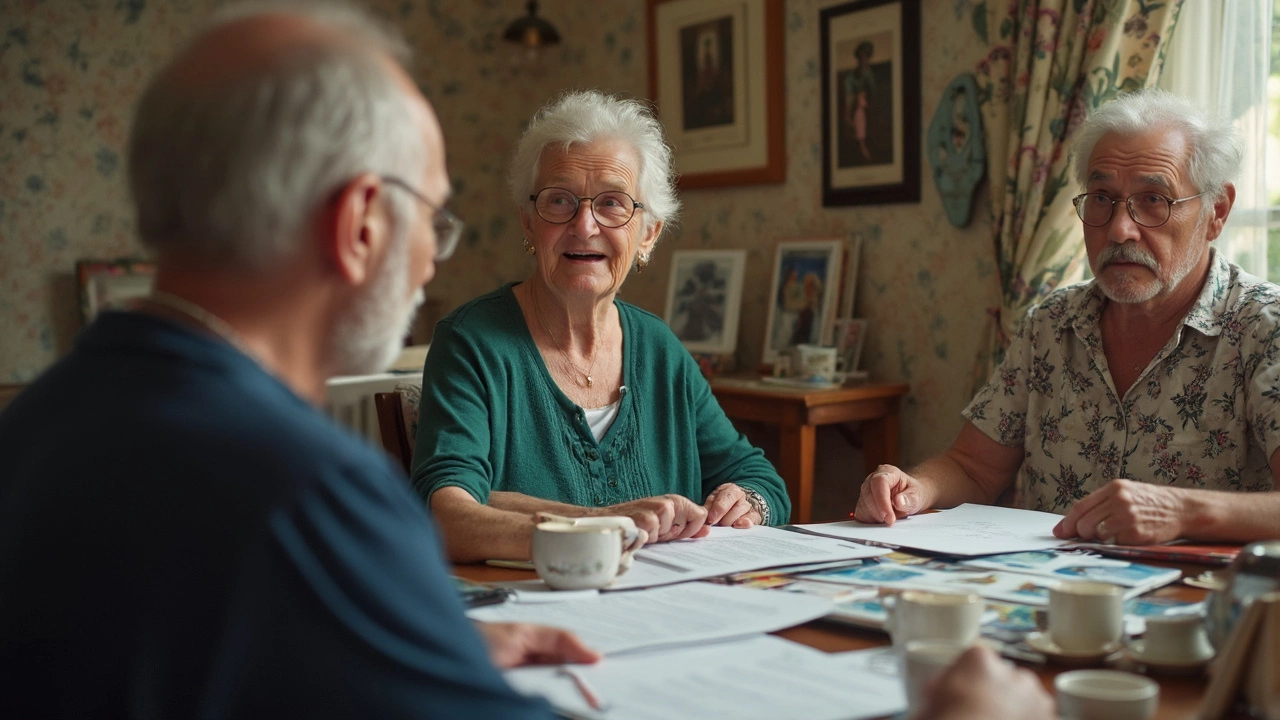Picture this: You’re staring up at the stairs from your living room, knowing that the climb’s gotten tougher by the day. Doctor’s orders say to limit strain, but your bedroom and bathroom are upstairs. A chairlift looks like a magic solution—some folks call it a stair lift. But then comes the big question: where can you get the money for it, and does Social Security help with this sort of thing? Spoiler: the system is not as straightforward as we wish.
What Social Security Actually Pays For
Let’s get right to the heart of it: Social Security at its core doesn’t cut checks for home modifications like chairlifts. Instead, Social Security pays two main benefits: Social Security Disability Insurance (SSDI) and Supplemental Security Income (SSI). Both help people with disabilities or low income with monthly cash payouts, but not specific home equipment. This means if you’re eyeing a chairlift, you won’t find a direct Social Security “chairlift benefit.” Don’t shoot the messenger!
What you might not know is that even though these programs don’t pay a vendor directly or hand you a voucher for a stair lift, your Social Security funds can be used however you need them—including home modifications—once they hit your bank. Technically, you could budget your monthly Social Security check and save up for a chairlift. But, let’s be real. Between rent, groceries, meds, and bills, tucking away thousands for a chairlift isn’t doable for most people getting Social Security alone—it pays, on average, $1,900 per month for SSDI as of 2025. SSI covers even less: the federal payment is just $943 monthly for individuals, and many receive less.
SSDI and SSI do play a role in qualifying you for help elsewhere—like Medicaid, state disability programs, or non-profit groups. They often ask for proof that you’re on Social Security before offering their own benefits. Hold on to that paperwork!
If you ever see claims online about “free chairlifts from Social Security,” don’t fall for it. The Social Security Administration (SSA) has zero direct programs to install or pay for stairlifts, as of June 2025. And if a sales site pushes this angle, be skeptical. Always check .gov sources or call SSA directly for the straight story.
Where the Money Really Comes From: Other Funding Sources
Here’s where things get interesting—or at least, less disappointing. Even if Social Security itself won't buy your chairlift, several programs might help, and qualifying for SSDI or SSI can unlock these doors. The trick is knowing where to look.
Medicare—the federal health program for folks over 65 or people under 65 with long-term disabilities—doesn’t cover stairlifts, period. It’s classified as a “home modification” or “mobility device,” not “durable medical equipment” (DME) under Medicare rules. If someone tells you otherwise, they’re mistaken. However, certain Medicare Advantage plans (those private plans that replace traditional Medicare) sometimes offer extra home modification help. You have to check what’s in your plan—coverage varies wildly year to year and company to company.
Medicaid is another story. Medicaid is needs-based, meaning if you’re on SSI, you probably qualify. Some state Medicaid programs do cover home modifications, including stairlifts, under “waiver” programs. Each state is different—some have generous waivers for people of all ages, others just for children or people in certain counties. New York and California, for instance, offer home modification benefits, but there are application hoops, waiting lists, and strict medical need requirements. Medicaid waivers are the #1 way stairlifts get paid for if you have low income and a documented disability.
There are other possible sources:
- Veterans’ Benefits: If you’re a veteran or spouse, the VA offers grants for home modifications, sometimes paying for chairlifts under the HISA or SAH grants. These cover eligible service-connected and age-related disabilities.
- State Assistance Programs: State agencies for aging or disability often have “Assistive Technology Act” projects that loan or subsidize the cost of stairlifts. Some even recycle used lifts, which are cleaned and checked for safety before being re-installed.
- Non-Profit Groups: Organizations like Rebuilding Together, United Way, or condition-specific groups may step in to help on a case-by-case basis. These usually require an application, income check, and sometimes a doctor’s note.
- Insurance Riders: Occasionally, private long-term care insurance, or rare add-ons to home insurance, will cover “accessibility modifications.” It's uncommon but worth checking your policy fine print.
Don’t forget local government housing grants and community development block grants. Some counties run programs to help people remain in their homes as they age or after an injury—these sometimes pay for stairlifts if “aging in place” saves the county money on nursing home costs.
| Program | Who Qualifies | Chance of Coverage | Extra Notes |
|---|---|---|---|
| Medicare | 65+, some under 65 with disabilities | Low | Rarely covers chairlift, check Medicare Advantage plan for extras |
| Medicaid Waivers | Low income, disability, state resident | Medium-High | Check your specific state for waiver list and eligibility |
| VA Programs | Veterans, spouses, dependents | High for eligible | HISA and SAH grants, medical need required |
| Non-Profits | Varies (often low income, specific conditions) | Medium | Application process, limited funds, may take longer |
| Local Housing Grants | Seniors, disabled residents | Medium | Some programs pay directly, others match applicants with re-used lifts |

Stair Lifts by the Numbers: Costs and Workarounds
If you’ve searched for chairlifts even once, you know these things are expensive. For a straight staircase, the average cost runs around $2,200 to $5,000 installed as of 2025. If your stairs have curves or a landing, the price jumps quickly—$8,000 to $12,000 isn’t unusual. Not a casual “just buy it” purchase for most of us! Lifts for outdoor or especially narrow staircases cost even more because of extra engineering.
Adding to the challenge, most lifts aren’t portable and must be matched to your specific staircase size and style. You can’t relocate a lift from an old house to a new one easily—or at least, not cheaply. Warranties vary too; you want at least a 2-3 year warranty for the motor, and lifetime on the track is ideal.
If insurance or grants aren’t an option, here are real-world tips that folks have used:
- Look for certified pre-owned or refurbished stairlifts. Reputable installers often have models that have been returned or lightly used, cutting the cost in half or more.
- Rent a stairlift. For temporary injuries or end-of-life care, some companies rent lifts by the month, which can be a fraction of the purchase price.
- Check classifieds and local Facebook groups. Sometimes a neighbor has a gently-used lift and will practically give it away, especially since removal/disposal can cost a fee.
- Ask your church or community group if they run a “loan closet” of accessibility gear—these are more common than you’d think, especially in tight-knit areas or bigger cities.
- Negotiate with the installer. Smaller companies sometimes offer payment plans or seasonal deals; don’t be afraid to ask for a quote that includes installation, warranty, and removal.
- Apply for crowdfunding or online fundraising. Sites like GoFundMe have real success stories for folks needing accessibility modifications, especially when you share your story and have local support.
- Tap into state Assistive Technology loan programs, which function like a library for medical gear, including chairlifts. You might be surprised what’s available, and they’ll advise you on safe installation.
Here’s something nerdy but cool: a survey published in the Journal of Aging & Social Policy (2023) found that seniors who got a stairlift ended up falling half as often on the stairs and were able to stay in their own homes an average of three years longer, compared to those who didn’t get one. Not only does a chairlift help prevent injury, but it saves on huge nursing home costs—for individuals and Medicaid alike.
If you’re going the fundraising route, remember that some benefits, including SSI, limit how much you can accept in gifts or donations before it impacts your monthly check. The rules are mind-numbingly complex, so before you crowdfund, check with a disability advocate or legal aid (they’ll walk you through reporting and banking the gift properly).
Making the Case: Steps for Getting Help With Chairlift Costs
Let’s talk game plan. Getting a chairlift covered takes some work, but you don’t have to figure it out alone. Here’s a roadmap:
- Get written proof of need. Have your doctor or occupational therapist write a note explaining why a stairlift is medically necessary. This is key for waivers, grants, and some nonprofits.
- Get paperwork in order. Gather your benefits letters, proof of income, recent medical records, and any proof of disability status—these will help unlock Medicaid, VA, or state program doors.
- Research your state’s Medicaid waivers. Google “Medicaid home and community based services” plus your state name or get in touch with your local Area Agency on Aging.
- Contact agencies directly. For veterans, call the VA’s home modification division. For others, reach out to your regional assistive technology project (every state has one thanks to federal law).
- Apply, apply, apply. These programs all require simple (but picky) forms. If your first answer is “no,” don’t give up—sometimes an appeal works, or another agency/charity has funds that didn’t show up in a Google search.
- Double-check the rules. Chairlifts sometimes have to be medically justified or can only be installed in owner-occupied homes—not rentals. If you’re a renter, the landlord needs to sign off (there are legal protections under the Fair Housing Act and Disability Act, but it can take time to process).
- Document everything. Save emails, letters, and notes about every conversation. The paper trail speeds up appeals and helps if a grant program has a waitlist. If you make a call, jot down who you spoke with and what was said. It pays off if you hit a snag later.
Here’s a sortable checklist for your search:
- Get written medical justification
- Collect SSDI/SSI award letters
- Check state Medicaid waivers
- Contact VA if a veteran/spouse
- Ask doctor or OT about local/county grants
- Compare stair lift models and ask for used or rental options
- Track all applications
- Prep for appeals if denied
- Review insurance and fundraising impacts on existing benefits
Now, if you do qualify for help, often the funding program will choose the installer, pick the model, and schedule an inspection. Don’t buy one before getting approval or you might be out of luck. Most grants and waivers won’t “reimburse” you for a past purchase unless you get a rare pre-authorization.
If you’re stuck waiting but need a chairlift now, look for local religious groups, rotary clubs, civic fraternal orders, or even local news stations running a “community helping community” feature. You never know who might sponsor a lift or do a fundraising drive in your honor, especially if your story highlights the risk of falls and the benefit of staying out of the hospital or nursing home.
At the end of the day, no one’s getting rich off SSDI or SSI—but these benefits are like a golden ticket to other programs, if you know where to look and how to ask. A social security check might open the first door, but getting that stairlift is usually a group effort, with some persistence, paperwork, and a little ingenuity sprinkled in for good measure.

